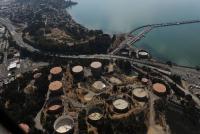Contra Costa Times editorial: Chevron retrofit can and should be worked out
Contra Costa Times editorial
© Copyright 2011, Bay Area News Group
Posted: 03/09/2011 04:00:00 PM PST
Updated: 03/09/2011 04:47:25 PM PST

Interstate 580 snakes around the Richmond Chevron Refinery in this aerial view on Thurday Oct. 14, 2010 in Richmond, Calif. (Susan Tripp Pollard/Staff)
LAST WEEK, the Richmond City Council unanimously approved a resolution calling on Chevron to resubmit its refinery retrofit plan. It is an action Chevron should welcome so that work can resume on a valuable project that will provide at least 1,000 well-paying construction jobs at a time when they are desperately needed.
It is unfortunate that a legal battle between Chevron and environmental groups has stalled the retrofit work for more than a year. That is especially true considering that the upgraded refinery is designed to be less polluting.
Chevron lost the initial legal fight and its appeal over its environmental impact report, which was ruled inadequate.
The impasse between Chevron and environmentalists was because of poor communication by the oil company and environmentalists' focus on what goes into the refinery rather than what is emitted. Backroom political dealing between Chevron and the city of Richmond certainly didn't help the situation either.
Environmental groups won a lawsuit and the appeal challenging Chevron's environmental impact report concerning the refinery's ability and intent to process heavier grades of crude oil. Plaintiffs argued that processing heavier grades of crude could increase air pollution.
Chevron contended that it did not plan to refine heavy grades of crude and that there are strict environmental rules in place to make sure pollution does not increase.
Yet it would not agree to a cap on the use of heavy crude because it did not want to set a precedent for regulating what goes into a refinery, and that it was not necessary.
That makes sense as long as emissions are strictly regulated. It is what comes out of a refinery that affects air quality, not necessarily what goes in.
However, Chevron might well have avoided its loss in the environmental lawsuit if it had produced an EIR that explicitly described the grades of oil the company would be able to process and the range of grades it planned to refine as well as a detailed analysis of their impact.
It is not too late for Chevron to do just that, and the sooner the better.
Richmond and the oil company are not that far apart on settling the EIR issue. Also, there are two new members on the City Council and the battle over competing refinery tax measures has been settled.
With a new spirit of cooperation among city officials, Chevron and environmentalists, along with a better understanding of what needs to be in the EIR, Chevron should be able to move ahead on its retrofit project in a timely manner.

